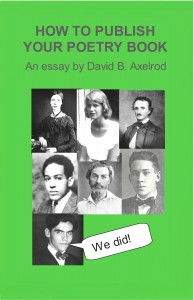POETRY STANDARDS: or, What I like in a Poem
by David B. Axelrod
Since poets now write largely blank (unrhymed) and free (unmetered) verse, often it can be hard to tell if what you read is even poetry! Certainly, whether you are reading a good or bad poem can be simply whether what you are reading is your “taste” or not. Are there no “standards” for poetry anymore? The test I most often apply to poems is whether I can believe them. There are poems written because someone said “I am a poet.” There are poems written because someone felt he or she needed to write a poem. I go with the latter. I guess, therefore, I ascribe to the belief or at least have the expectation that poetry is the language of feeling.
A poem that is written for poetry’s sake at best can appeal to poets. It’s like trading baseball cards. An objective observer is likely to ask, “How could you spend hundreds of dollars for that little piece of cardboard?” Only people really into something can appreciate its fine points. Most folks, however, are no more likely to appreciate the value of a piece of cardboard imprinted with baseball data than they are to like poetry written for poetry’s sake. Poems about poetry are “poets’ poetry.”
A poem written because it needs to be said, however, has a more universal appeal. It is a starting place for credibility and with that, empathy. Unless I believe the poem, how can I think it is real or good? I’m not trading baseball cards here; I’m communicating.
In a “felt” poem, one path (getting in touch with one’s feelings) has sought to conjoin with another (the craft of poetry). There is a confluence of energy. The language emerges from one’s consciousness to communicate a personal feeling to another reader or listener. Given the difficulty we all have when we actually try to say what we mean—and be understood by others—poetry becomes a powerful tool for communication. A well-written poem can not just give a voice to our feelings, it can actualize others—engage their empathy.
That is why poetic formalism, even when exercised with even the greatest precision, as often still feels like just a “drill.” It may show mastery of form, dexterity and even great invention of language, but ultimately, if it is only form—for form’s sake—it is not what I like in a poem.
Without “content, “ a poem is just an exercise, a drill, words marching in step. Art is not just artifice, though as often that’s all we are offered. When a poem says, “Here is how I have survived, “ when it offers a life being lived, then there is a chance for excellence. The only chance we have beyond our own survival is that transfer of some energy, some life-force from ourselves to another.
That transfer of energy happens so dramatically and clearly in birth. It happens so sweetly and simply in the caress of a loving hand. It can happen sometimes in a poem. The gift of language, the freshness of vision, the whole history of everything previously written and read can come together in a few lines so that one existence energizes another.
The effect is quite remarkable—an “anti-bullet.” All the bad intentions, the toxins, the wounds that have been inflicted are addressed in those few seconds as the poem is read and the good is transferred. How remarkable we humans are that we can do this with mere words. All the technology, all the gadgets, all apps aside, just a few odd letters, sounds strung together and one life has helped another along.
For those who might now be saying, “This is too mystical. Too diffuse, ” what would you rather I say makes a good poem? Shall we now pick up our plumes and just rhyme? Very well then…
For all the poems that talk of posies,
for all the people who rhyme their rosies,
if this is what you like in poetry,
I’m just as glad if you don’t show it to me.
SMILE…




